How to use ProcDump to create crash dump files on Windows 10
On Windows 10, ProcDump is a control-line tool specifically designed to create crash dump files manually. A "dump" is a special file that contains (all or parts) of the data loaded in memory at the time dump was triggered. Commonly, you would use this file for assay to determine the root of a problem with an app or the OS.
Although Windows 10 tin create crash dumps files automatically when it encounters an mistake that it cannot handle, sometimes you may still demand to generate these files manually. For example, if you are a developer and yous are testing a new awarding. Or when an app is not responding or constantly crashing, and yous need to send the details to the software vendor support to investigate the issue.
Whatsoever the reason might be, the Microsoft ProcDump tool is a slap-up tool you can use in Command Prompt to create a crash dump file in many dissimilar ways, including generating a minidump file using the app or process name or process ID. You can also use the tool to create multiple dumps at different intervals automatically. Or you tin can specify other criteria, such as when the process reaches a specific processor usage, the app is unresponsive, and more.
In this Windows 10 guide, we will walk y'all through the steps to utilise the Microsoft ProcDump tool to generate dump files manually on your device.
- How to install ProcDump on Windows ten
- How to utilise ProcDump on Windows 10
How to install ProcDump on Windows 10
To install the ProcDump command-line tool on Windows 10, utilize these steps:
- Open up ProcDump official page.
-
Click the Download ProcDump link.
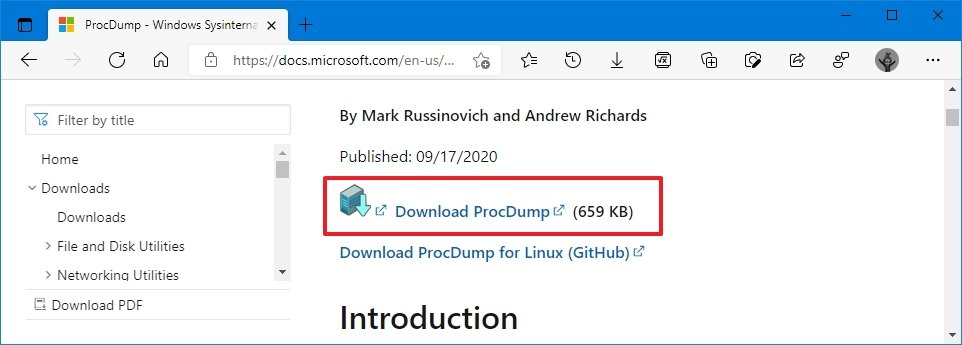 Source: Windows Central
Source: Windows Central - Save the file on the device.
- Open up the zip folder.
-
Click the Extract all option from the "Compressed Folder Tools" tab.
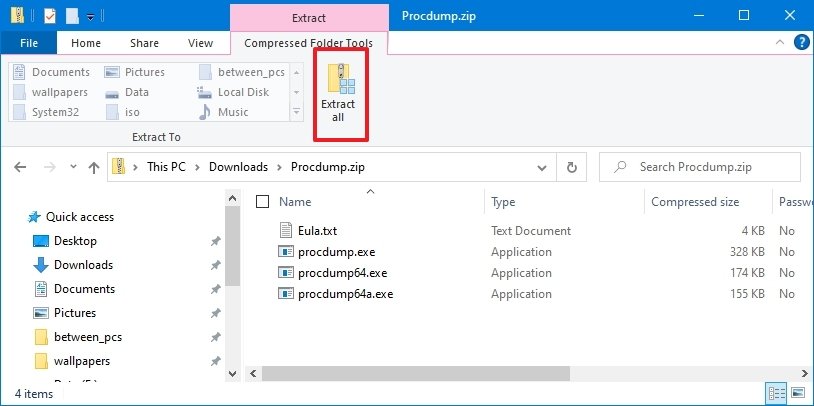 Source: Windows Central
Source: Windows Central -
Ostend a path to extract the files.
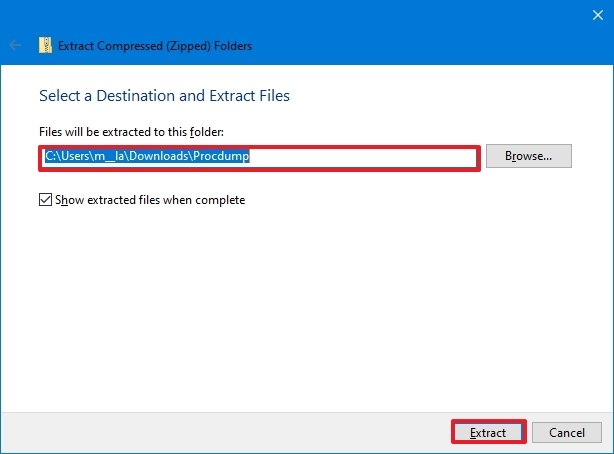 Source: Windows Central
Source: Windows Central - Cheque the Show extracted files when complete option.
- Click the Extract button.
Once yous complete the steps, you can apply ProcDump with Command Prompt to create dumps files on Windows 10.
How to use ProcDump on Windows x
The ProcDump tool includes many options to tape and create dump files. In the steps below, we will show yous a bunch of examples to create a dump file for a specific awarding and dissimilar scenarios, including when a procedure is unresponsive, crashes, uses a significant amount of processor resources, and more than.
To get started with the ProcDump tool, use these steps:
- Open Starting time.
- Search for Control Prompt, correct-click the top outcome, and select the Run as administrator option.
-
Blazon the following command to navigate to the folder containing the ProcDump tool and press Enter:
cd C:\PATH\TO\PROCDUMPIn the control, make sure to update the path with the folder's location with the ProcDump tool.
For example, this control opens the tool location inside the "Downloads" folder:
cd C:\Users\username\Documents\Procdump -
Blazon the following control to create a minidump file of a running app and press Enter:
procdump APP-Proper nameIn the command, replace APP-Name for the executable name of the app.
This instance creates a dump file for the File Explorer app:
procdump explorer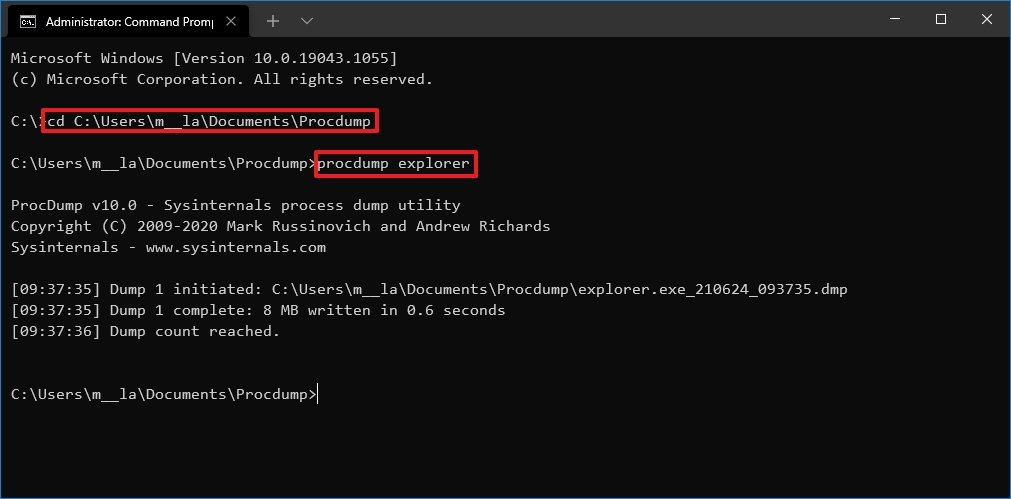 Source: Windows Central
Source: Windows Central -
Type the post-obit command to create a dump file using the process ID of the app and printing Enter:
procdump Process-IDIn the command, replace Process-ID with the actual ID of the procedure or awarding.
This example creates a dump file for File Explorer with the process ID of 6468:
procdump 6468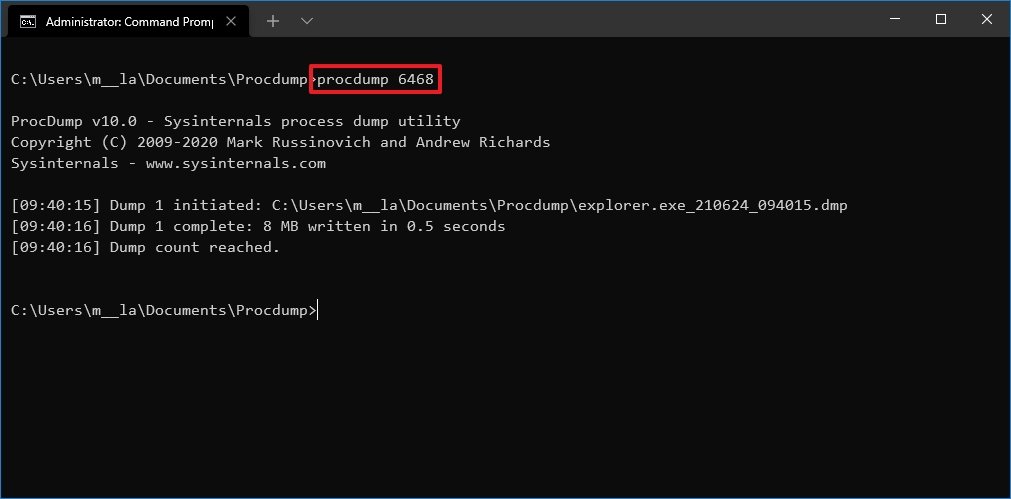 Source: Windows Primal
Source: Windows Primal Quick tip: You can always ostend the process ID (PID) of an app in the Details tab of Task Managing director or using the
tasklistcommand. -
Type the following command to create a full dump file for an application and printing Enter:
procdump -ma APP-OR-PIDIn the command, replace APP-OR-PID for the name or process ID of the app.
This example creates a full dump file for File Explorer:
procdump -ma explorer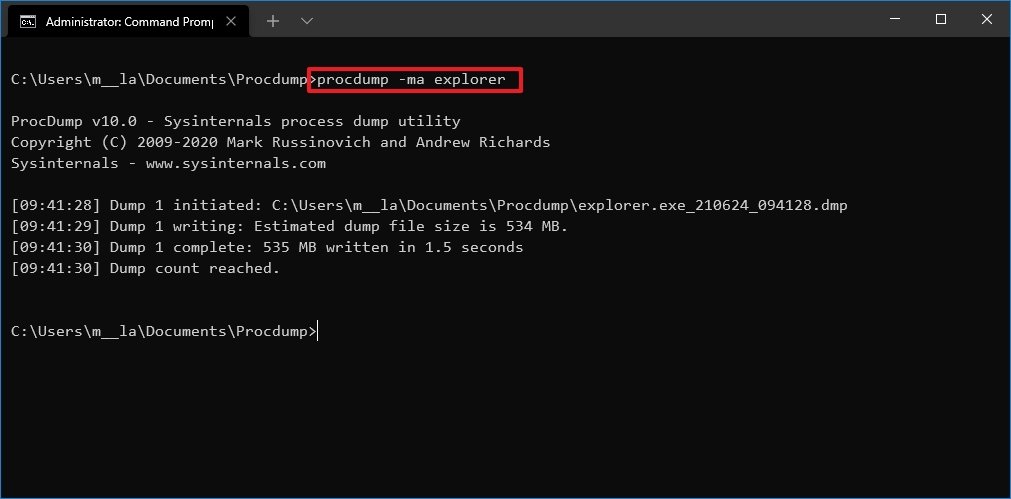 Source: Windows Central
Source: Windows Central Quick annotation: A total dump file contains everything available in memory related to the application. In contrast, a minidump file is merely several megabytes in size, and it includes basic information about the awarding.
- Confirm the location of the .dmp file.
Later you complete the steps, the dump file will be generated in the ProcDump folder.
Create multiple minidumps manually
To use ProcDump to create multiple minidump files on Windows 10, use these steps:
- Open Start.
- Search for Control Prompt, correct-click the acme consequence, and select the Run as administrator pick.
-
Blazon the following control to navigate to the folder containing the ProcDump tool and printing Enter:
cd C:\Users\username\Documents\Procdump -
Type the following command to write v minidumps 15 seconds apart from 1 another and press Enter:
procdump -south 15 -north v Process-NAMEIn the command, supplant the PROCESS-Name for the proper name of the process you want to write a dump. As well, remember to update the 15 for the number of seconds to wait before generating a new file and 5 for the number of dump files yous desire to create.
This example writes 5 dump files for the Windows Explorer process:
procdump -due south 15 -n 5 explorer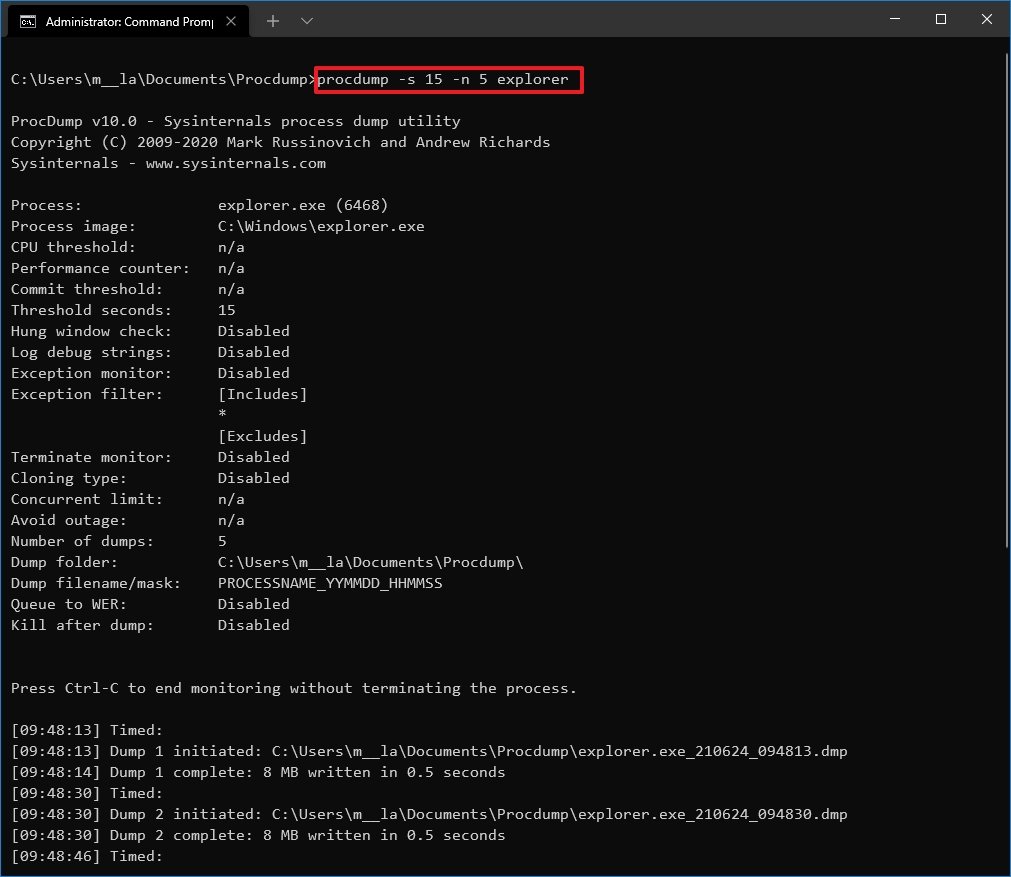 Source: Windows Primal
Source: Windows Primal
Once yous complete the steps, the tool will create (in this instance) five dump files 15 seconds apart from i some other.
Create minidumps based on processor usage
To write a dump file after the app system usage reaches a specific threshold, utilise these steps:
- Open First.
- Search for Control Prompt, correct-click the elevation result, and select the Run as administrator selection.
-
Type the post-obit command to navigate to the folder containing the ProcDump tool and press Enter:
cd C:\Users\username\Documents\Procdump -
Type the post-obit command to write a minidump file when the process exceeds the 20% processor usage for 15 seconds and press Enter:
procdump -c 20 -s 15 PROCESS-NameIn the command, replace the Process-NAME for the name of the process you desire to write a dump. As well, call up to replace xx and 15 for processor usage and a wait fourth dimension in seconds.
This case writes a dump file of the explorer.exe process that uses over 20% of processor resource for 15 seconds:
procdump -c 20 -s fifteen explorer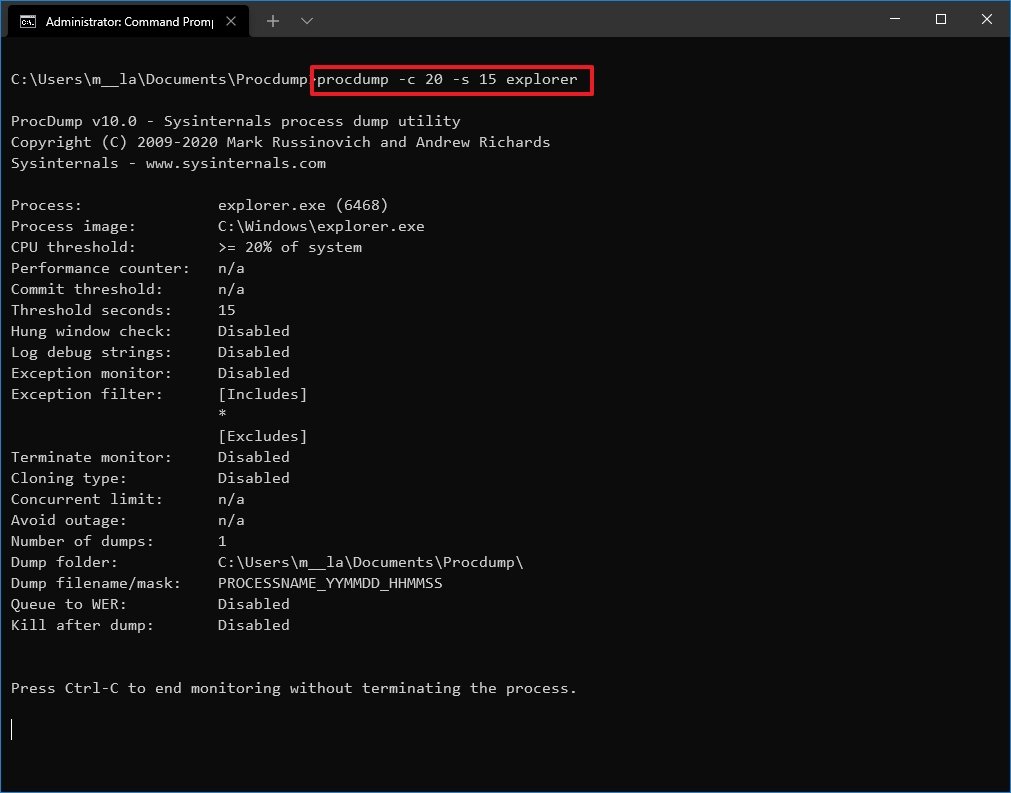 Source: Windows Cardinal
Source: Windows Cardinal -
(Optional) Type the following command to write an error dump file when a specific app pushes processor usage to a higher place twenty% for ten seconds and printing Enter:
procdump PROCESS-NAME -p "\Processor(_Total)\% Processor Time" xxThis example writes a dump file of the explorer.exe process that uses over 20% of processor resource for ten seconds:
procdump explorer -p "\Processor(_Total)\% Processor Time" 20
Afterward you lot complete the steps, the command will monitor the awarding, and when information technology exceeds the processor usage for the time you specified, and then a dump file will exist generated.
Create minidumps for unresponsive process
To create a minidump as soon every bit a process is unresponsive, use these steps:
- Open up Get-go.
- Search for Command Prompt, right-click the summit result, and select the Run every bit ambassador option.
-
Blazon the following control to navigate to the folder containing the ProcDump tool and press Enter:
cd C:\Users\username\Documents\Procdump -
Blazon the post-obit command to write a minidump file when a process becomes unresponsive for more than v seconds and press Enter:
procdump -h PROCESS-NAME DUMP-NAME.dmpIn the control, replace the PROCESS-NAME for the name of the process you want to monitor and DUMP-Proper name for the file's name.
This example writes a dump when the Windows Explorer process becomes unresponsive for five seconds:
procdump -h explorer explorer-unresponsive-data.dmp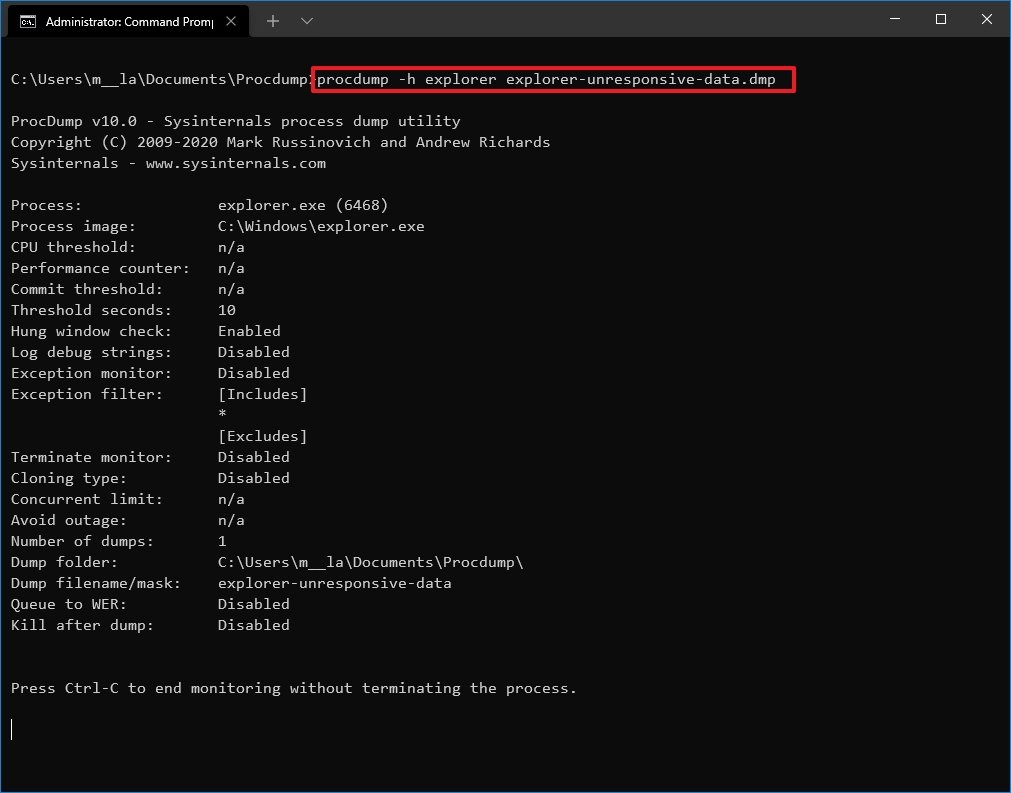 Source: Windows Cardinal
Source: Windows Cardinal
In one case yous complete the steps, a dump file will exist written to the ProcDump folder when the application becomes unresponsive.
Create minidump during launch of a process
To launch an app, proceed monitoring it, and write a dump file when an exception occurs, use these steps:
- Open up Start.
- Search for Command Prompt, right-click the tiptop consequence, and select the Run as administrator option.
-
Type the following command to navigate to the folder containing the ProcDump tool and press Enter:
cd C:\Users\username\Documents\Procdump -
Type the following command to start an app and create a dump file when information technology crashes, and printing Enter:
procdump -e i -f "" -x C:\PATH\TO\STORE\DUMP "C:\PATH\TO\APP.EXE"In the control, supersede C:\PATH\TO\Shop\DUMP for the folder location to shop the dump. Also, change C:\PATH\TO\APP.EXE for the path of the app you want to monitor and create a dump.
This example creates a dump file of Google Chrome when information technology crashes and stores the "dump" file within the dumps binder:
procdump -due east 1 -f "" -x C:\dumps "C:\Programme Files\Google\Chrome\Application\chrome.exe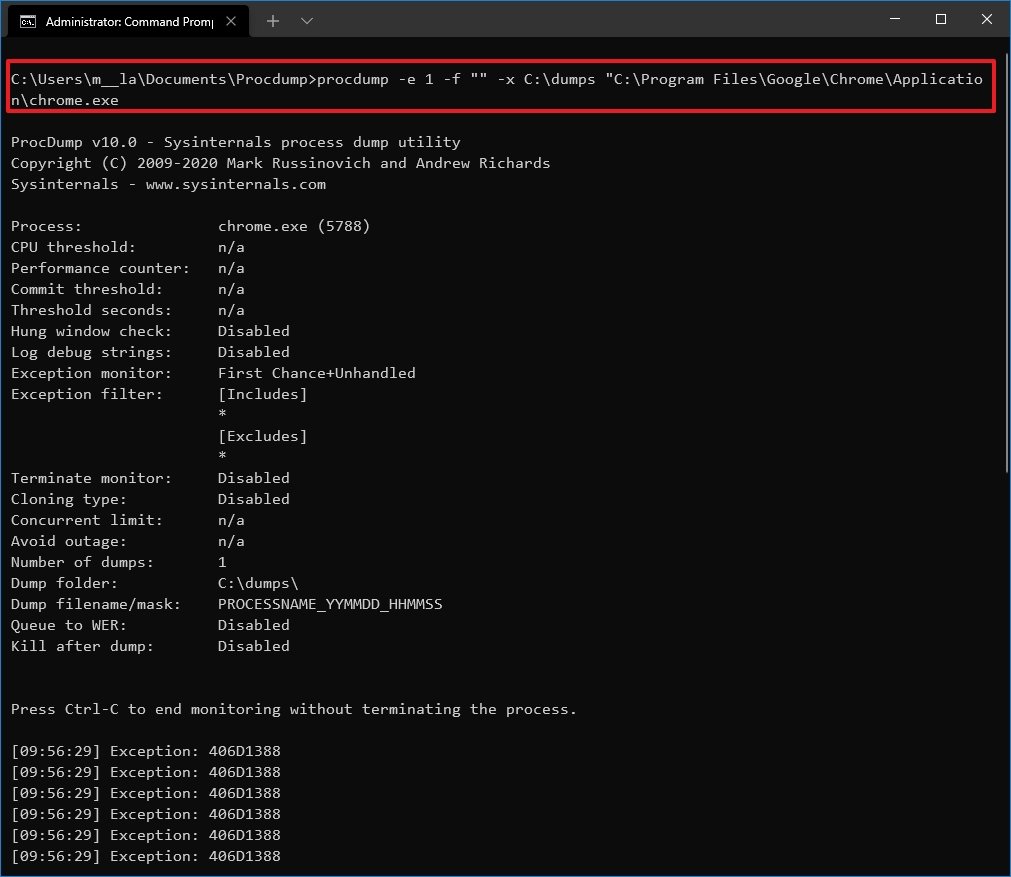 Source: Windows Fundamental
Source: Windows Fundamental
Afterwards yous complete the steps, the tool volition launch and monitor the app, and when it crashes, information technology will create a dump file in the folder location you specified.
Activate Postmortem Debugger to create full dump automatically
Y'all tin also register the tool as a Postmortem Debugger to allow ProcDump to monitor and automatically write a full dump when one or more than processes crash. Here's how:
- Open Start.
- Search for Command Prompt, right-click the acme result, and select the Run as administrator option.
-
Type the following command to navigate to the binder containing the ProcDump tool and press Enter:
cd C:\Users\username\Documents\Procdump -
Blazon the following command to monitor and create a full dump file when one or more processes crash and press Enter:
procdump -ma -i C:\PATH\TO\STORE\DUMPIn the control, supercede C:\PATH\TO\STORE\DUMP for the location to store the dump file.
This examples stores the total dump file in the "dumps" binder:
procdump -ma -i C:\dumps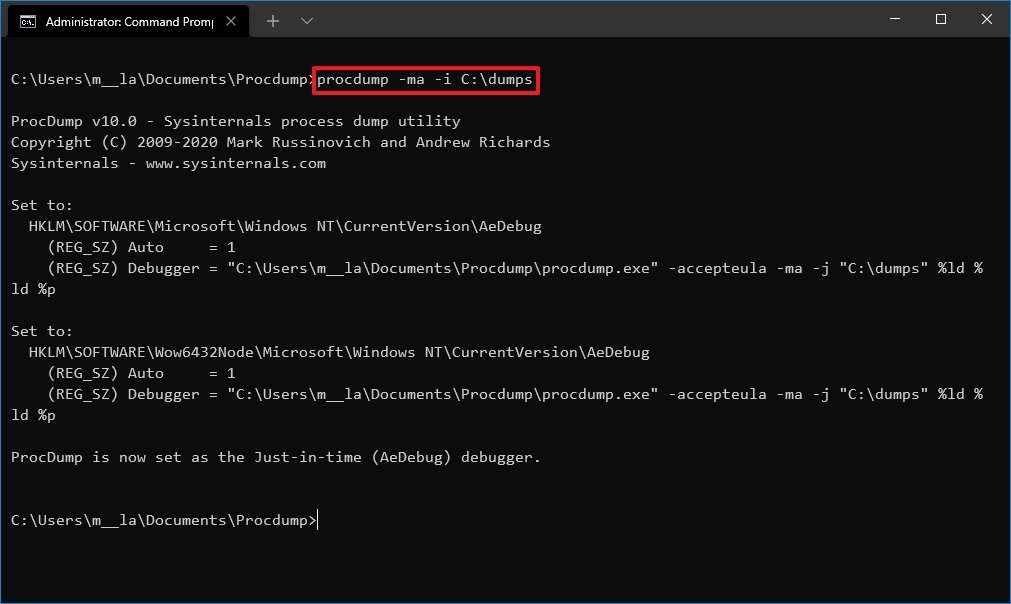 Source: Windows Central
Source: Windows Central
Once y'all complete the steps, the ProcDump tool will monitor the system, and it volition create dump files whenever an application crashes.
We are focusing simply on some bones examples. You lot can always run the procdump -e control to review all the available options.
More Windows 10 resources
For more helpful articles, coverage, and answers to common questions about Windows 10, visit the post-obit resource:
- Windows 10 on Windows Central — All you lot demand to know
- Windows 10 help, tips, and tricks
- Windows x forums on Windows Primal
Nosotros may earn a committee for purchases using our links. Learn more.

Future plans for FFXIV
Post-launch roadmap for Final Fantasy XIV: Endwalker revealed
The latest Letter from the Producer livestream has only aired, and information technology comes with a plethora of news for Last Fantasy XIV. This includes plans for updating all the main scenario quest dungeons, improving the graphics, implementing new sidequests, and much more.
Source: https://www.windowscentral.com/how-use-procdump-create-dump-files-windows-10
Posted by: kellerchomem.blogspot.com













0 Response to "How to use ProcDump to create crash dump files on Windows 10"
Post a Comment